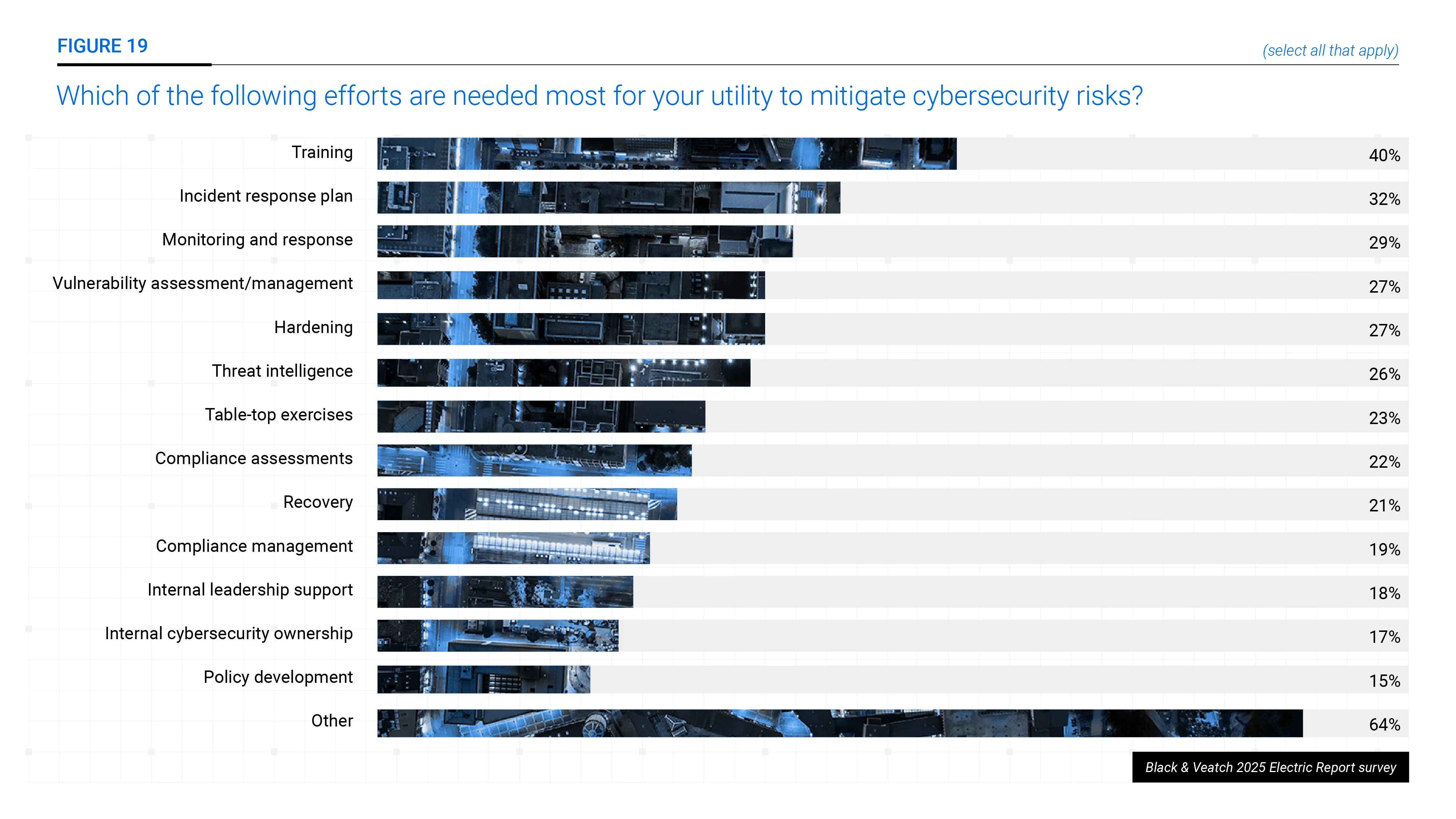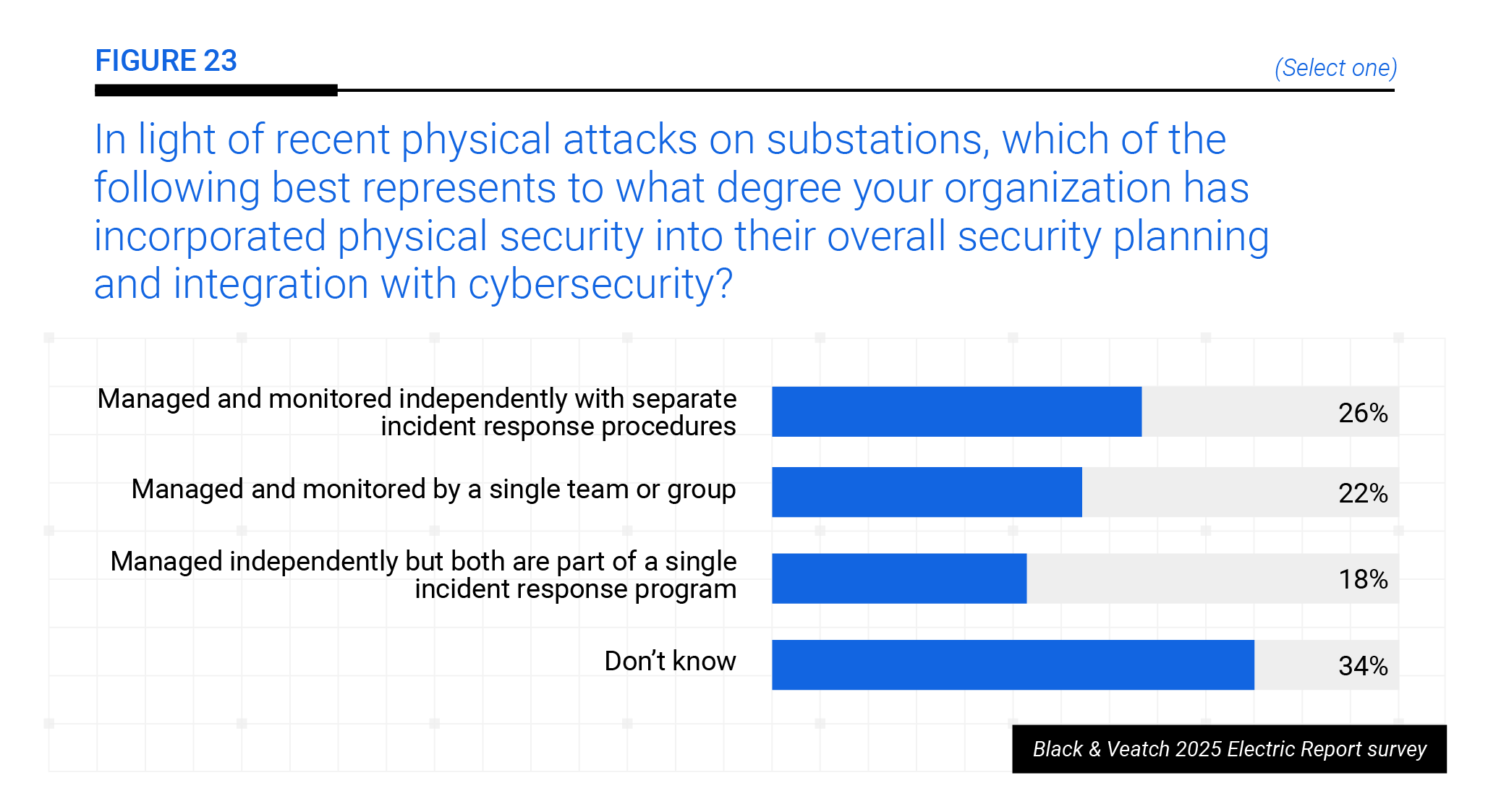
2025 Electric Report
Infused with insights from 500 U.S. energy industry stakeholders, Black & Veatch’s 2025 Electric Report is the benchmark to see where you stand — and where to lead next.

Make 2026 the year your electric utility goes from compliant to true cyber resilience. That means embedding cybersecurity throughout an asset’s lifecycle, promoting a cyber aware culture and focusing on impact. According to the 2025 Black & Veatch Electric Report, only 19% of respondents now rank compliance assessments as a priority, demonstrating that utilities are moving past assessments and are ready to act.

But what are the top cybersecurity actions utilities can take in 2026 for true resilience? The following are five recommendations.
Physical and cyber risks are intertwined (for example, attackers can use malware to compromise or spoof physical security measures before physically accessing the substations unnoticed.) But the 2025 Electric Report found that 34% of respondents don’t fully understand how physical and cyber risks intersect.

Time to close this dangerous gap. Consider the following actions to enhance physical security measures:
Use access control systems, surveillance cameras and security personnel to safeguard facilities such as substations, data centers and control rooms.
Regularly conduct physical security assessments, ensure proper lighting around sensitive areas and maintain secure perimeters with fencing and alarms.
Integrate physical security protocols with cybersecurity strategies to provide comprehensive protection against both digital and physical threats.
Leverage newer offerings of AI-powered surveillance systems and analytics to strengthen physical security at utility facilities.
Use predictive analytics to assess vulnerabilities in perimeter defenses and recommend proactive measures to reduce risk.
The utility sector is in a high-risk era driven by digital transformation, regulatory mandates and increasingly sophisticated adversaries. What does threat detection look like in 2026?
Deploy AI, ML, and behavioral analytics with IDS and SIEM for real-time threat detection and OT network visibility.
Keep energy sector threat intelligence feeds updated and integrated into detection systems.
Promote IT-OT collaboration for unified monitoring and coordinated incident response.
Regularly tune detection rules and train staff to interpret alerts for maximum effectiveness.
The 2025 Electric Report found that malware, cloud vulnerabilities and ransomware are the cyber threats utilities are most concerned about. Protect against these threats by securing legacy systems and OT devices. Consider the following recommendations:
Inventory and assess assets to find vulnerable legacy devices and their operational importance.
Use secure gateways or protocol converters so legacy devices connect [GA1] without direct exposure.
Segment networks to isolate legacy systems, applying strict access controls and monitoring.
Apply virtual patching or compensating controls for unpatchable devices; add IDS for industrial protocols to monitor traffic.
Adopt IIoT platforms for secure data collection, predictive maintenance, and analytics without major equipment changes.
Incidence response planning was a top priority for utilities in 2025, according to the Electric Report. Utilities are all the better for it as the energy sector will continue to face a convergence of regulatory, technological and threat-driven pressures in 2026. Here are tips for enhancing your incidence response planning to meet the moment.
Outline procedures for detecting, reporting, containing, eradicating and recovering from cyber incidents.
Assign clear roles and responsibilities, maintain updated contact lists and establish communication protocols for internal and external stakeholders.
Conduct regular tabletop exercises and live drills to test plan effectiveness and employee readiness.
Consider partnering with third-party incident response services to bolster preparedness. These external experts can provide immediate support during major cyber incidents, supplementing internal teams with specialized knowledge and tools.
Running a modern grid requires staff who understand both operational systems and cyber risks. That’s why leading utilities prioritized cybersecurity training above all other cyber related activities in 2025, according to the Electric Report. By continuing to foster technical proficiency and cyber literacy in 2026, utilities empower their workforce to proactively identify risks and leverage modern solutions to safeguard critical infrastructure. Here’s what that looks like in 2026:
Develop a comprehensive cybersecurity training program tailored to various roles within the utility. Training should cover topics such as password hygiene, phishing, social engineering and safe use of mobile devices.
Supplement mandatory training with periodic awareness campaigns, simulated phishing exercises and policy updates.
Encourage a culture of reporting suspicious activity and reward proactive security behavior.
In addition to general cybersecurity awareness, utilities should implement targeted training programs focused on new technologies and the use of advanced cyber solutions.
Give employees hands-on instruction for emerging tools such as AI-driven threat detection platforms, industrial IoT devices and security information and event management (SIEM) systems.
Conduct regular workshops and online modules to help staff stay current with evolving cyber controls, best practices for secure system integration and effective response strategies for technology-driven threats.
In 2026, leading utilities will prioritize a resilient, integrated approach to cybersecurity. As operations become more connected, automated and complex, utilities will advance their capabilities in physical security, threat detection, incident response, legacy and OT device protection, workforce training and more. The goal: cybersecurity that’s built in, not bolted on.
To learn more about cyber resilience, and Black & Veatch’s consequence-driven approach to cybersecurity, download the 2025 Electric Report today.
